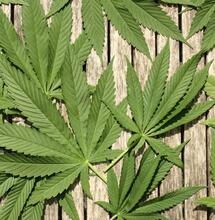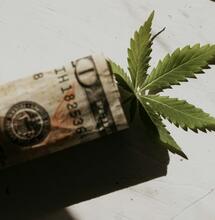Dime Bag Might Actually Cost a Dime if Weed Were Legal
_24.jpg)
Pot legalization could result in a joint costing 'a few cents', according to a new book
Pot legalization could result in a joint costing 'a few cents', according to a new book
It continues to be totally off the radar of prominent politicians, but polls indicate that large and growing numbers of Americans are open to the idea of legalizing marijuana. Gallup broke ground last fall with the first-ever poll showing 50 percent of respondents nationwide wanting to legalize, and a more precisely worded poll from Rasmussen in May had 56 percent in favor of "legalizing marijuana and regulating it in a similar manner to the way alcohol and tobacco cigarettes are regulated today."
Thus far those polls are outliers, and most surveys show more voter skepticism than that. But as elderly voters are more pot-phobic than the young, legalization's support is likely to increase over time and surely it will work its way onto the national agenda sooner or later. There's been relatively little analysis of what a legal marijuana industry might look like. One key but little-appreciated fact is that, according to persuasive research by Jonathan Caulkins, Angela Hawken, Beau Kilmer, and Mark Kleiman in their new book Marijuana Legalization: What Everyone Needs To Know, is that legal pot would be amazingly cheap. In fact, midgrade stuff would be so cheap that it might make sense for businesses to give it away like ketchup packets or bar nuts.
Conventional thinking about pot pricing is often dominated by people's experience buying weed in legal or quasi-legal settings such as a Dutch "coffee shop" or a California medical marijuana dispensary. But this is badly misleading. Neither California nor the Netherlands permit growing or wholesale distribution of marijuana as a legal matter. If pot were fully legal, its growth, distribution, and marketing would work entirely differently. There are some goods that are sufficiently costly to store-either because they're alive like lobsters or because they're giant like RVs-such that either the retail markup is a big deal or else retail purchases can't be made in convenient locations. But marijuana is a nonperishable bulk commodity like wheat or lentils.
For such commodities, the final price to the end user is dominated by the cost of production. Try to imagine a world in which you're allowed to have some tomatoes in your house, you're allowed to cook tomatoes, you're not punished for having tomatoes in your possession if the cops stop you, and you're even allowed to buy tomatoes at specialty tomato stores-but where it's illegal to actually grow tomatoes. The price of tomatoes is going to escalate enormously. The problem isn't that the tomatoes will suddenly disappear from supermarket shelves (though they will) but that all the farms will have to shut down. Which isn't to say that nobody will grow tomatoes. People like tomatoes. So tomatoes will be smuggled in from Mexico.
Tomatoes will be grown in backyards. People will use lights and hydroponic rigs to grow tomatoes indoors. These expedients would work, but they'd be horrendously inefficient compared with the modern agricultural, packaging, and transportation methods. America's farmlands are some of the most productive in the world, thanks in no small part to technology and the existence of scale sufficient to leverage that technology. Even what Americans think of as a small family farm is quite large compared with an illicit marijuana operation. There are no amber waves of cannabis anywhere in the world today, but under a true legalization regime there would be. And this makes all the difference. How cheaply could pot be grown with advanced farming techniques? One potential data point is Canada's industrial hemp industry, where production costs are about $500 per acre.
If the kind of mid-grade commercial weed that accounts for about 80 percent of the U.S. market could be grown that cheaply, it implies costs of about 20 cents per pound of smokable material: Enough pot to fill more than 800 modest-sized half-gram joints for less than a quarter!. Those numbers are probably optimistic, since in practice recreational marijuana is grown from more expensive transplanted clones rather than from seeds. Even so, the authors note that "production costs for crops that need to be transplanted, such as cherry tomatoes and asparagus, are generally in the range of $5,000-$20,000 per acre." That implies costs of less than $20 per pound for high-grade sensimilla and less than $5 a pound for mid-grade stuff. Another way of looking at it, suggested by California NORML Director Dale Gieringer, is that we should expect legal pot to cost about the same amount as "other legal herbs such as tea or tobacco," something perhaps "100 times lower than the current prevailing price of $300 per ounce-or a few cents per joint."
This would make pot far and away the cheapest intoxicant on the market, absolutely blowing beer and liquor out of the water. Joints would be about as cheap as things that are often treated as free. Splenda packets, for example, cost 2 or 3 cents each when purchased in bulk. These data either bolster or undermine the case for legalization, depending on your point of view. On the one hand, despite the apparent widespread availability of pot even under prohibition, it seems likely that radically lowering the price would lead to a much larger increase in consumption than people have in mind. On the other hand, it seems that you could tax the hell out of marijuana and still leave consumers better off than they are today. An extraordinarily high tax, of course, would spark tax evasion.
Right now, people smuggle marijuana across the U.S.-Mexico border for profits of about $20 an ounce, so a tax substantially higher than that could be tricky to enforce. Still, a $20/ounce tax would be about triple the per-weight taxation of cigarettes, while still leaving mass-market weed extremely affordable. Unfortunately, marijuana taxation is not a game-changer for fiscal policy terms. Federal cigarette taxes bring in about $10 billion a year. Even heavy pot smokers don't smoke nearly as much as cigarette addicts, so even at triple taxation we're talking about low single-digit billions in revenue-not nothing, but hardly transformative to the overall budget. Still the transformation of the basic economics of the marijuana industry-and knock-on effects for casinos, bars, and other possible complements or substitutes for pot-would be enormous. The superficial ineffectiveness of prohibition masks a huge impact on the supply side that, for better or for worse, is what stands between America and much cheaper highs. SOURCE: www.huffingtonpost.com AUTHOR: Matthew Yglesias, Slate



